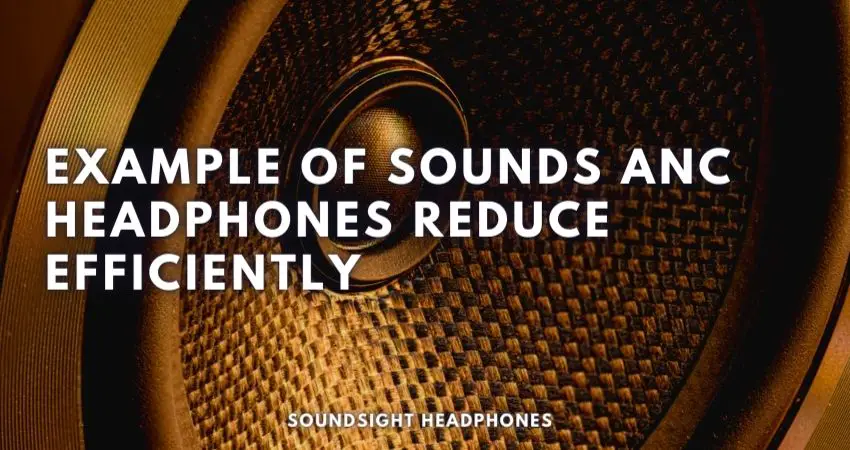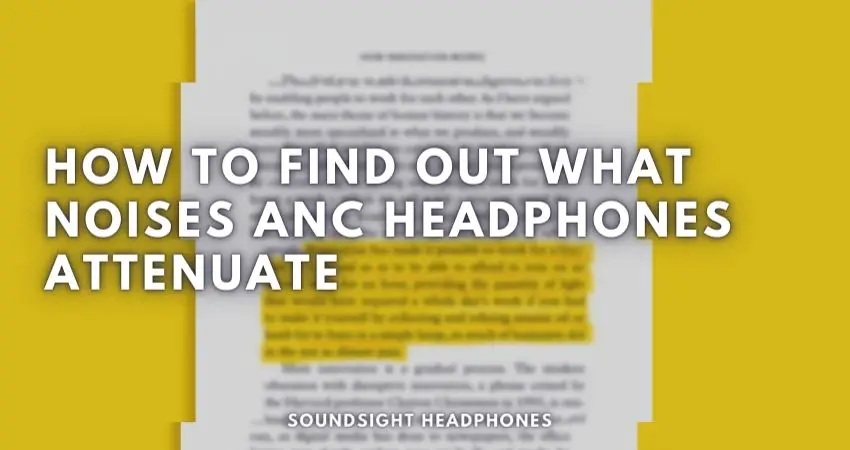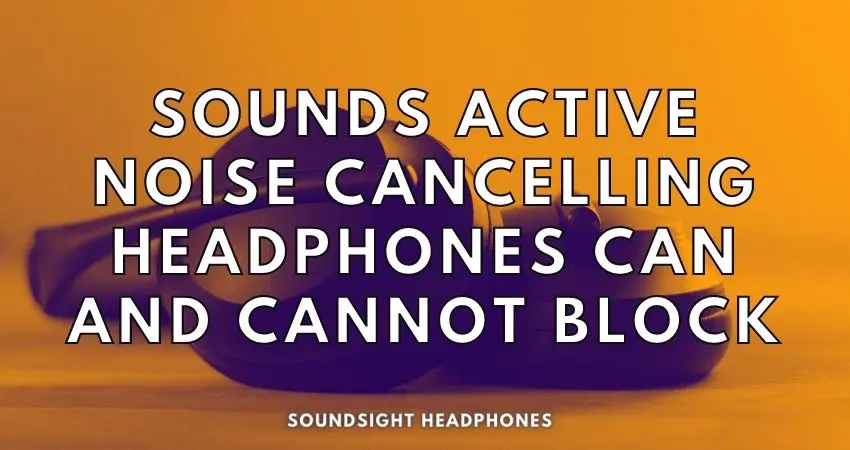The amplitude and frequency range of everyday sounds are determined by the sound source. Depending on the nature of these sounds, their intensity, and the noise reduction power of your headphones, it is possible to determine which sounds can be filtered out and which cannot. Knowing this information helps you decide if active noise-canceling headphones can reduce surrounding noise and if they are right for you.
This article seeks to help you understand the capabilities of noise-canceling headphones, provide a list of everyday sounds that can and cannot be blocked by noise-canceling headphones, and explain what is necessary to reduce ambient sounds.
Types of Sounds ANC Headphones can Block
Active noise-canceling headphones have two ways of attenuating noise. One is passive noise reduction through ear cups that prevent noise from entering your ears. The other is by canceling outside noise with active components built into the headphones.
The types of sounds that can be blocked by active noise-canceling headphones are:
- Low amplitude sounds, such as air conditioner, PC, and refrigerator
- Sounds reproduced in the lower frequency range such as conversation, low rumbling bass, and fan noise
Low-amplitude but high-frequency sounds such as voices, harmonics, violin, or flute in musicals are difficult to block with active noise cancellation, even if they are not loud. The opposite is true for high amplitude, low frequency sounds like vacuum cleaners or jackhammers.
Low frequencies via ANC, high-frequencies via passive noise reduction
If you have read about the differences between active and passive noise reduction, you probably already know that:
- Active noise reduction is for low frequencies (20 Hz – 1000 Hz).
- Passive noise reduction is for the mid and high frequencies (1,000 Hz – 20,000 Hz).
When you buy a pair of ANC headphones, you focus on isolating the sound from devices that produce low-frequency sounds like rumbling engines and humming aircraft engines, but that doesn’t mean high-frequencies pass through.
Although the ANC system cannot block high-frequency sounds, the headphones’ sound-isolating properties handle high frequencies well. In fact, high frequencies are reduced by an average of -30 dB to -45 dB, whereas the best ANC headphones reduce low frequencies by -15/25 dB.

Example of sounds ANC headphones reduce efficiently
Here is a list of all the sounds that can be reduced to a large extent by ANC headphones. This list is based on multiple studies, research, and tests.
Indoor sound sources:
- Tick of a windup clock
- Air conditioner
- Refrigerator
- Computer
- Hot air conditioning system
- Exhaust fan
- Printer
- Window fan
- Alarm clock
- Quiet office
- Background music
- Normal conversation
- Normal laughter
- Dishwasher
- Microwave
- Clothes Dryer
- Printer
Other sounds sources ANC headphones attenuate:
- Breathing
- Snoring
- Footsteps
- Bat sonar clicks
- Ultrasonic cleaner
- Quartz watch
- Rustling leaves
- Hummingbird fighting
- Rainfall
- Car horn
- Car engine
- Fire alarm
- Dog barking
- Thunder
- That annoying kid next door
High amplitude devices (sound sources ANC headphones struggle to block):
- City traffic
- Construction site
- Hairdryer
- Electric can opener
- Vacuum cleaner
- Coffee grinder
- Electric mixer
- Lawnmower
- Air compressor
- Leaf blower
- Circular saw
- Motorcycle
- Jackhammer
- Power saw
- Chainsaw
- Leaf blower
- Electric drill
- Ambulance siren
- Shotgun
- Truck air horn
- Gunshot
- Train horn
- Concert
Sources:
- https://survivallife.com/sound-frequency-weapon/
- https://www.nonoise.org/library/household/index.htm
- https://www.researchgate.net/figure/1-Examples-of-sound-pressure-levels-in-dB-and-corre-sponding-sound-pressure-in-Pa-of_tbl1_235418964

How to find out what noises ANC headphones attenuate
First of all, to find out what noises your ANC headphones can cancel or attenuate considerably, we need to know three things:
- The amplitude level of various sounds
- The frequency range of these sounds
- Headphones noise reduction in these frequency ranges
- Distance and number of sound sources.
Explaining sound amplitude and frequency
The amplitude represents the intensity or strength of a sound wave. The higher the amplitude, the more difficult it is to attenuate.
The sound amplitude or sound pressure is the force of a sound wave at the point where it reaches the ear. The lower the amplitude, the softer and quieter it should be. Each sound has an amplitude and group of frequencies; for example: a car horn reproduces frequencies between 200-500 Hz.
- A microwave has an amplitude of 55-59 dB and a frequency between 60 Hz – 200 Hz, produced by the internal electronics.
- Two people talking – about 40 dB amplitude and frequency between 85 Hz – 155 Hz for men and 165 to 255 Hz for women.
- A vacuum cleaner – about 84-89 dB of amplitude with frequencies between 20 Hz and 20,000 Hz, the loudest frequencies between 500 Hz and 2,000 Hz.
Here’s a list of sounds with their amplitude in dB:
Most home appliances are in the lower amplitude levels, and the maximum volume reached is about 60 – 70 dB, except for devices like machinery, coffee grinder, and hairdryer.
Most devices listed produce frequencies in the low and mid-range. As such, depending on the amplitude of the sounds, they’re most likely to be suppressed by powerful ANC headphones.
Distance from sound sources
The distance and amount of sound sources are used to determine the amount of sound energy entering your ear. The shorter the distance or more noise sources, the more sound energy there is. Higher sound energy or higher sound amplitude is harder to attenuate than lower sound energy.
Let’s say your ANC headphones have a noise reduction rating of -20 dB in the 20 Hz – 1000 Hz frequency range. In other words, the intensity of the noise close to your ear is reduced by 20 dB.
To know how loud a car honk is, you have to keep in mind three things:
- Sound amplitude
- Distance
- The decibel scale
Loudness follows an inverse square law, which means that a car honking at a distance of 10 meters will be 100 times less loud than the sound of a car honking at a distance of 1 meter.
Intensity = Energy/(Time * Area)
The decibel has a logarithmic scale of 10 * log10(I1/I2), where I1 and I2 are the relative powers of the sound. A car honk has around 100 – 110 decibels. At 10 meters, the sound intensity decreases to 80–90 dB. You can use this distance attenuation calculator for easier calculations.
Number of sound sources
We know that a car honking at 10 meters is 90 dB. Now, if two vehicles are honking at a distance of 10 meters, the intensity doesn’t become 180 dB. The decibel has a logarithmic scale, so if one sound is 90 dB and there are two, the total intensity must be converted back into a linear scale, which is 93 dB. 90 dB + 90 dB becomes 93 dB instead of 180 dB.
You can use this formula:
10xlog10(10^(90/10)+10^(90/10)) = 93 dB.
Or you can use this Decibel calculator to add or subtract decibels.
Other sources:
- https://sound.pressbooks.com/chapter/intensity-and-distance-april-2019-version/
- https://www.youtube.com/watch?v=Qnz4uKnJWww&ab_channel=EngineeringMathematicI
How do ANC headphones cancel loud sounds
A microwave appears to be loud at 55-59 dB for active noise-canceling headphones that reduce the noise by -20 dB. But the experienced sound signal has a lower intensity as it travels. At 2 meters, the sound has a lower intensity of about 50 dB. At about 10 meters, the sound is only about 35 dB, which is more manageable for your ANC headphones.
When companies state that their active noise-canceling headphones reduce sounds by 20 dB, that’s not the noise-canceling power but the total noise reduction.
If you subtract 20 dB from 35 dB using the formula LA−LB=LA+log10(1−10−(LA−LB)10), you end up with 34.9 dB, so that seems off because the headphones are not actually reducing the noise by that much.
In reality, the noise reduction power of the headphones is as high as the sound amplitude of the noise source.
FAQ regarding the ANC headphones and noises they are eliminating
Will a headphone with noise reduction of -20 dB cancel out all the sounds that are around me?
No. The noise reduction power will attenuate most of the noises, depending on their intensity. As explained, amplitude and frequency also play a role. Distance and number of sound sources are also taken into account. For example, if you’re in a crowded city with loud traffic, a -25 dB noise reduction will suffice. You’d have to go for the best ANC headphones like Sony WH-1000XM4, Apple AirPods Max, or Bose QC 35 II.
Which is the best ANC headphone?
Sony WH-1000XM4 is the best active noise-canceling headphone in terms of noise reduction. Apple AirPods Max is also in high demand, but they’re too expensive for the average consumer looking for a balance between ANC power, affordability, and long battery.
Can ANC headphones attenuate office sounds?
Yes. The ANC headphones can cancel out the noise of a printer, clock ticking, keyboard typing, and other office sounds, but you shouldn’t expect them to block loud chatters or coffee grinders. If you already have an active noise-canceling headphone, you can use it in a noisy office. On top of that, music at medium volume levels can also mask up the noise and help you concentrate.
Can ANC reduce construction noises?
Construction site noise is among the hardest noise to cancel out. The sound waves are at low frequencies; therefore, there’s little chance for ANC headphones to block them. However, due to the high amplitude of these noises, you can still hear them even through the ANC of your headphones.
If you’re a construction worker, you’re susceptible to noise-induced hearing loss due to the constant exposure to loud noises at close range, especially if you work with heavy equipment. So, it’s recommended that you wear earplugs or other specialized hearing protection devices.
Can noise-canceling headphones reduce car engine noise?
A car’s idling engine produces a constant deep low-frequency noise which can be blocked by ANC headphones with good sub-bass noise reduction. Bowers & Wilkins PX7 or Bose QuietComfort 35 II, as most noise-canceling headphones struggle attenuating noise sub 20 Hz and above 1,000 Hz.
While the Sony WH-1000XM4 and Apple AirPods Max are fantastic active noise-canceling headphones, they are ineffective at reducing frequencies below 20 Hz to block out the noise of idling car engines.
When the car engine operates at faster Rpm, especially Rpm above 2,000 Rpm, and the noise produced becomes much louder than the engine’s idle, the frequency range raises.
Conclusion
While the power of the noise-canceling headphones is quite impressive, it is not 100% perfect. It is possible to hear some sounds through the Active Noise Cancelling Headphones. This is because some sounds are either too powerful or outside the range of frequencies that ANC headphones can eliminate.
In the end, hope this article has helped explain the noise reduction capabilities of headphones, the types of sounds they can eliminate, and answered most of your questions. If you still have questions, concerns, or comments about this article, please comment below.
